International Trade: Ngai Tuhu Farming Product Export Analysis
VerifiedAdded on 2021/11/17
|18
|4386
|56
Report
AI Summary
This report examines the complexities of international trade, specifically focusing on the export of Ngai Tuhu Farming products from New Zealand. It analyzes the significance of the Treaty of Waitangi, emphasizing the importance of partnership, biculturalism, and multiculturalism in fostering successful trade relationships. The report outlines strategies to enhance the relationship with Ngai Tuhu Farming, considering the company's cultural foundations. It also delves into different business structures, recommending a Limited Liability Company for the venture, and explores the influence of micro and macro environmental factors like suppliers, customers, competition, demographics, economics, technology, and political factors. The report further discusses the application of the Factor Endowment Theory in export businesses and covers non-tariff barriers such as import bans, quotas, and embargos. The analysis aims to provide a comprehensive understanding of the factors affecting international trade in the context of exporting New Zealand products.
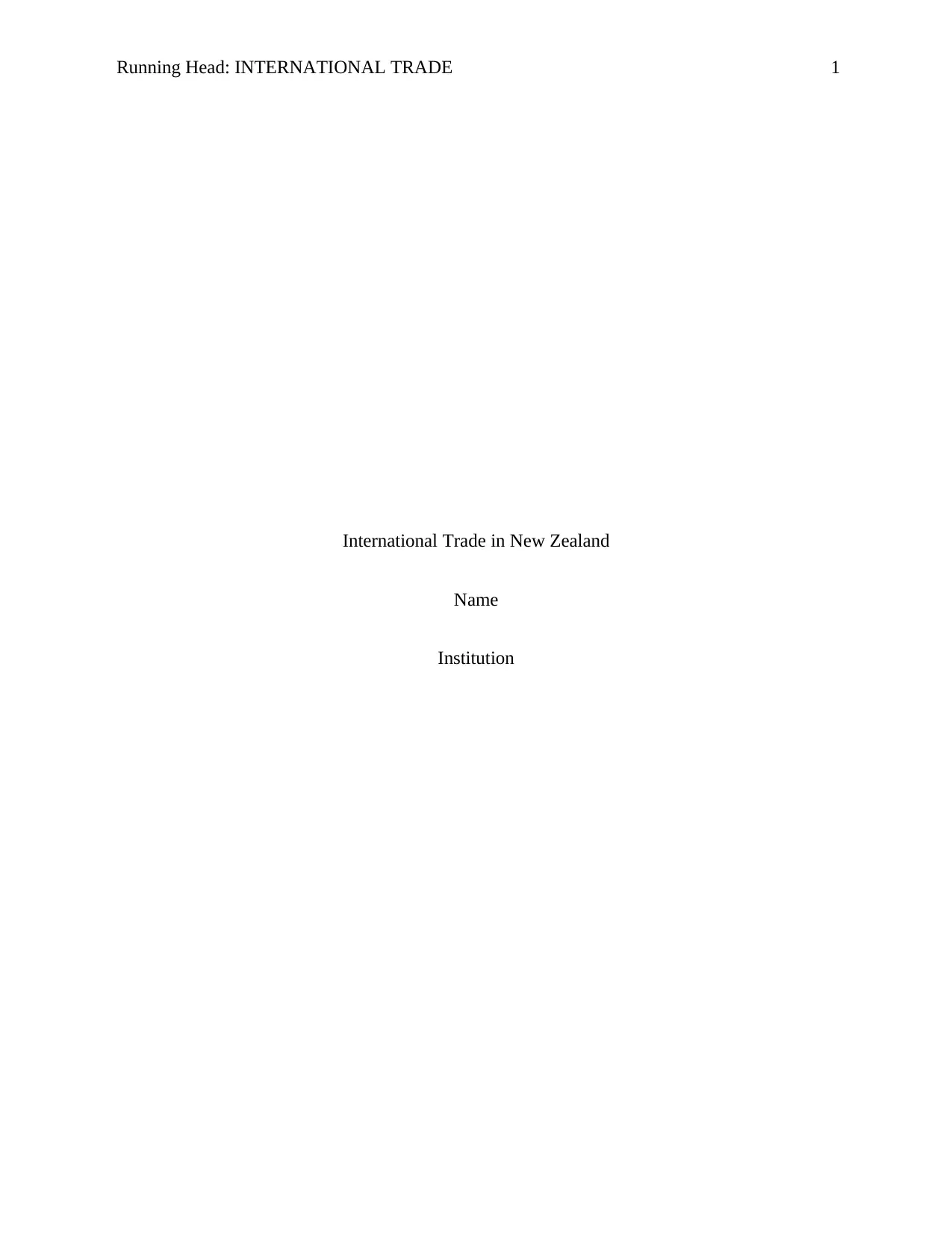
Running Head: INTERNATIONAL TRADE 1
International Trade in New Zealand
Name
Institution
International Trade in New Zealand
Name
Institution
Paraphrase This Document
Need a fresh take? Get an instant paraphrase of this document with our AI Paraphraser
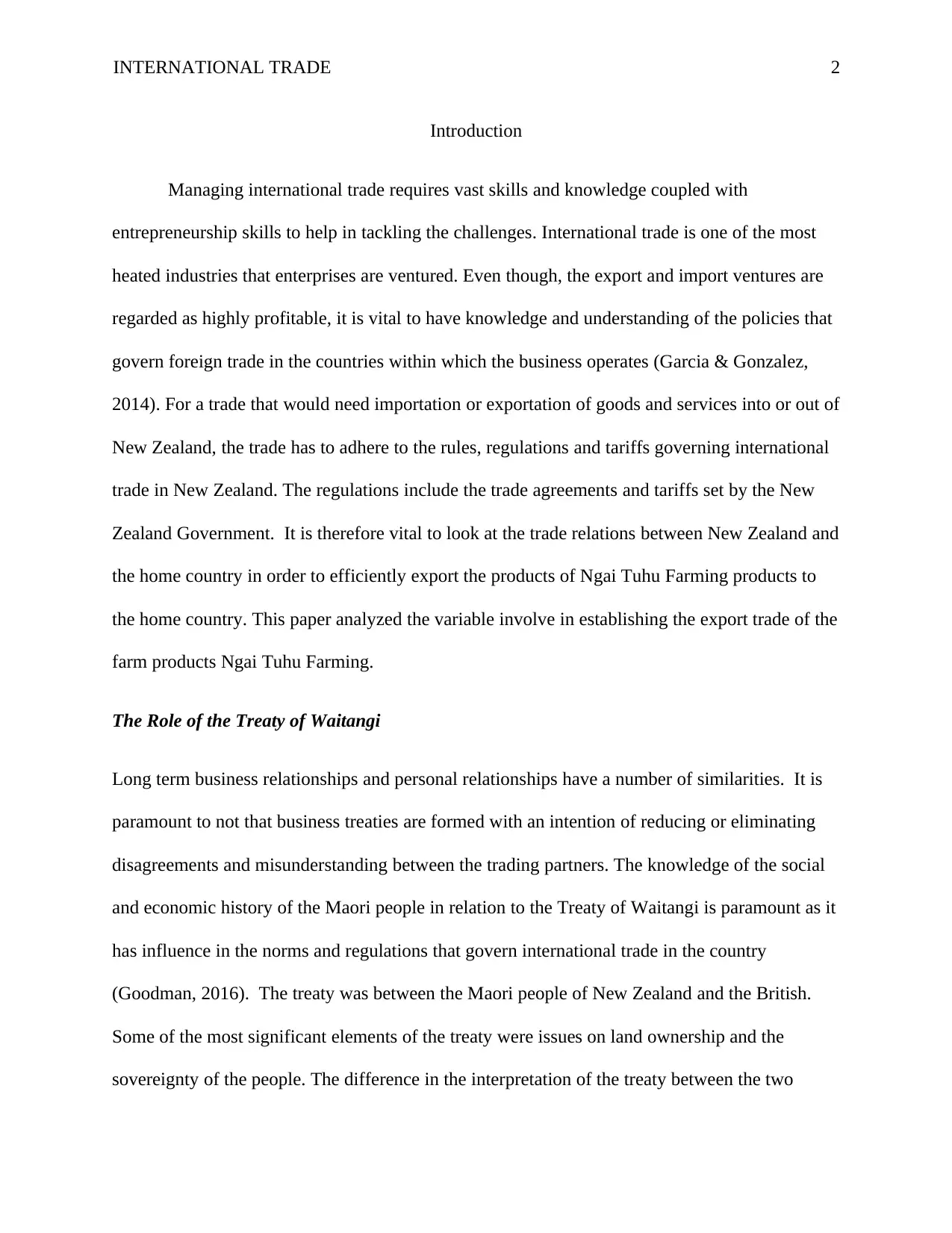
INTERNATIONAL TRADE 2
Introduction
Managing international trade requires vast skills and knowledge coupled with
entrepreneurship skills to help in tackling the challenges. International trade is one of the most
heated industries that enterprises are ventured. Even though, the export and import ventures are
regarded as highly profitable, it is vital to have knowledge and understanding of the policies that
govern foreign trade in the countries within which the business operates (Garcia & Gonzalez,
2014). For a trade that would need importation or exportation of goods and services into or out of
New Zealand, the trade has to adhere to the rules, regulations and tariffs governing international
trade in New Zealand. The regulations include the trade agreements and tariffs set by the New
Zealand Government. It is therefore vital to look at the trade relations between New Zealand and
the home country in order to efficiently export the products of Ngai Tuhu Farming products to
the home country. This paper analyzed the variable involve in establishing the export trade of the
farm products Ngai Tuhu Farming.
The Role of the Treaty of Waitangi
Long term business relationships and personal relationships have a number of similarities. It is
paramount to not that business treaties are formed with an intention of reducing or eliminating
disagreements and misunderstanding between the trading partners. The knowledge of the social
and economic history of the Maori people in relation to the Treaty of Waitangi is paramount as it
has influence in the norms and regulations that govern international trade in the country
(Goodman, 2016). The treaty was between the Maori people of New Zealand and the British.
Some of the most significant elements of the treaty were issues on land ownership and the
sovereignty of the people. The difference in the interpretation of the treaty between the two
Introduction
Managing international trade requires vast skills and knowledge coupled with
entrepreneurship skills to help in tackling the challenges. International trade is one of the most
heated industries that enterprises are ventured. Even though, the export and import ventures are
regarded as highly profitable, it is vital to have knowledge and understanding of the policies that
govern foreign trade in the countries within which the business operates (Garcia & Gonzalez,
2014). For a trade that would need importation or exportation of goods and services into or out of
New Zealand, the trade has to adhere to the rules, regulations and tariffs governing international
trade in New Zealand. The regulations include the trade agreements and tariffs set by the New
Zealand Government. It is therefore vital to look at the trade relations between New Zealand and
the home country in order to efficiently export the products of Ngai Tuhu Farming products to
the home country. This paper analyzed the variable involve in establishing the export trade of the
farm products Ngai Tuhu Farming.
The Role of the Treaty of Waitangi
Long term business relationships and personal relationships have a number of similarities. It is
paramount to not that business treaties are formed with an intention of reducing or eliminating
disagreements and misunderstanding between the trading partners. The knowledge of the social
and economic history of the Maori people in relation to the Treaty of Waitangi is paramount as it
has influence in the norms and regulations that govern international trade in the country
(Goodman, 2016). The treaty was between the Maori people of New Zealand and the British.
Some of the most significant elements of the treaty were issues on land ownership and the
sovereignty of the people. The difference in the interpretation of the treaty between the two
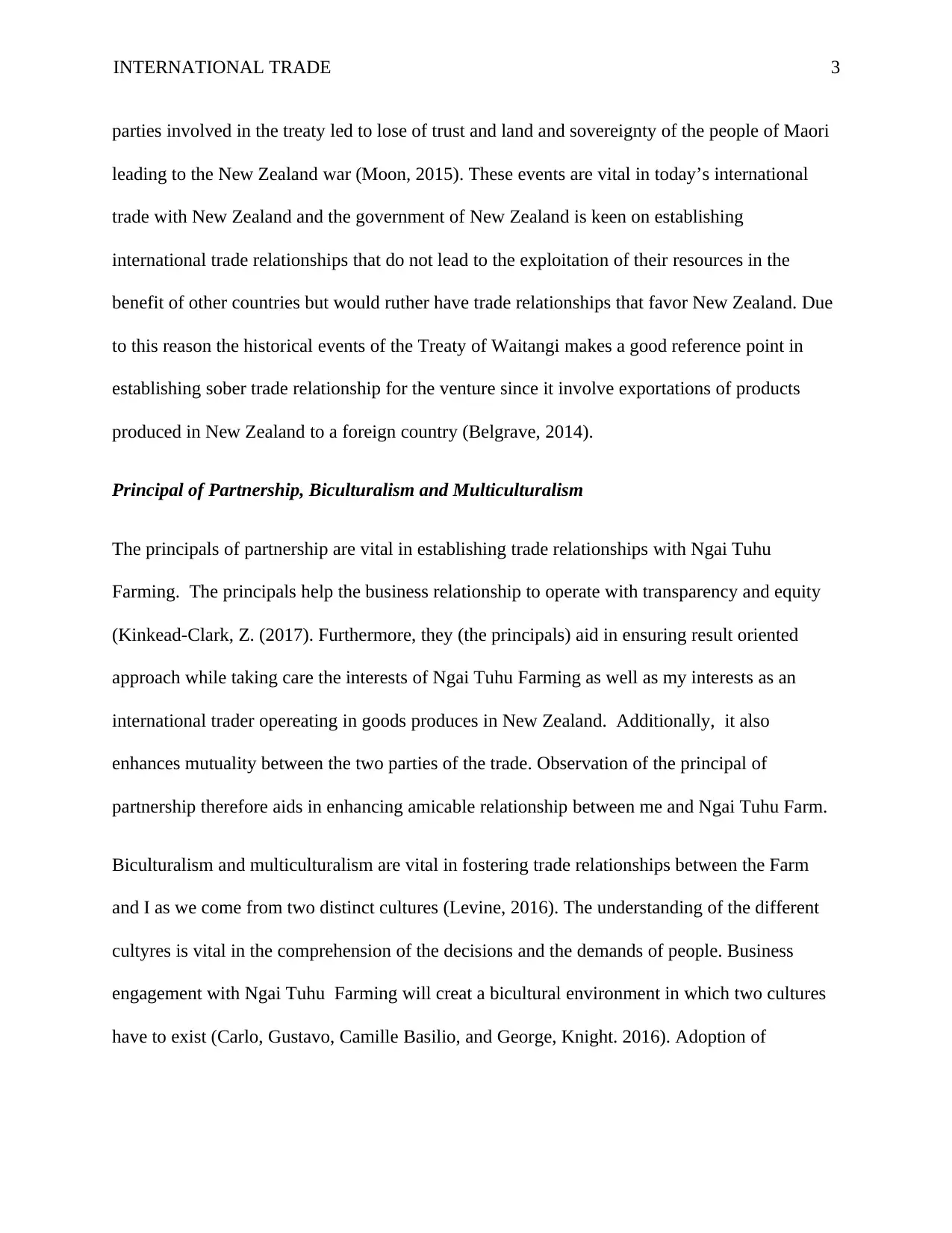
INTERNATIONAL TRADE 3
parties involved in the treaty led to lose of trust and land and sovereignty of the people of Maori
leading to the New Zealand war (Moon, 2015). These events are vital in today’s international
trade with New Zealand and the government of New Zealand is keen on establishing
international trade relationships that do not lead to the exploitation of their resources in the
benefit of other countries but would ruther have trade relationships that favor New Zealand. Due
to this reason the historical events of the Treaty of Waitangi makes a good reference point in
establishing sober trade relationship for the venture since it involve exportations of products
produced in New Zealand to a foreign country (Belgrave, 2014).
Principal of Partnership, Biculturalism and Multiculturalism
The principals of partnership are vital in establishing trade relationships with Ngai Tuhu
Farming. The principals help the business relationship to operate with transparency and equity
(Kinkead-Clark, Z. (2017). Furthermore, they (the principals) aid in ensuring result oriented
approach while taking care the interests of Ngai Tuhu Farming as well as my interests as an
international trader opereating in goods produces in New Zealand. Additionally, it also
enhances mutuality between the two parties of the trade. Observation of the principal of
partnership therefore aids in enhancing amicable relationship between me and Ngai Tuhu Farm.
Biculturalism and multiculturalism are vital in fostering trade relationships between the Farm
and I as we come from two distinct cultures (Levine, 2016). The understanding of the different
cultyres is vital in the comprehension of the decisions and the demands of people. Business
engagement with Ngai Tuhu Farming will creat a bicultural environment in which two cultures
have to exist (Carlo, Gustavo, Camille Basilio, and George, Knight. 2016). Adoption of
parties involved in the treaty led to lose of trust and land and sovereignty of the people of Maori
leading to the New Zealand war (Moon, 2015). These events are vital in today’s international
trade with New Zealand and the government of New Zealand is keen on establishing
international trade relationships that do not lead to the exploitation of their resources in the
benefit of other countries but would ruther have trade relationships that favor New Zealand. Due
to this reason the historical events of the Treaty of Waitangi makes a good reference point in
establishing sober trade relationship for the venture since it involve exportations of products
produced in New Zealand to a foreign country (Belgrave, 2014).
Principal of Partnership, Biculturalism and Multiculturalism
The principals of partnership are vital in establishing trade relationships with Ngai Tuhu
Farming. The principals help the business relationship to operate with transparency and equity
(Kinkead-Clark, Z. (2017). Furthermore, they (the principals) aid in ensuring result oriented
approach while taking care the interests of Ngai Tuhu Farming as well as my interests as an
international trader opereating in goods produces in New Zealand. Additionally, it also
enhances mutuality between the two parties of the trade. Observation of the principal of
partnership therefore aids in enhancing amicable relationship between me and Ngai Tuhu Farm.
Biculturalism and multiculturalism are vital in fostering trade relationships between the Farm
and I as we come from two distinct cultures (Levine, 2016). The understanding of the different
cultyres is vital in the comprehension of the decisions and the demands of people. Business
engagement with Ngai Tuhu Farming will creat a bicultural environment in which two cultures
have to exist (Carlo, Gustavo, Camille Basilio, and George, Knight. 2016). Adoption of
⊘ This is a preview!⊘
Do you want full access?
Subscribe today to unlock all pages.

Trusted by 1+ million students worldwide
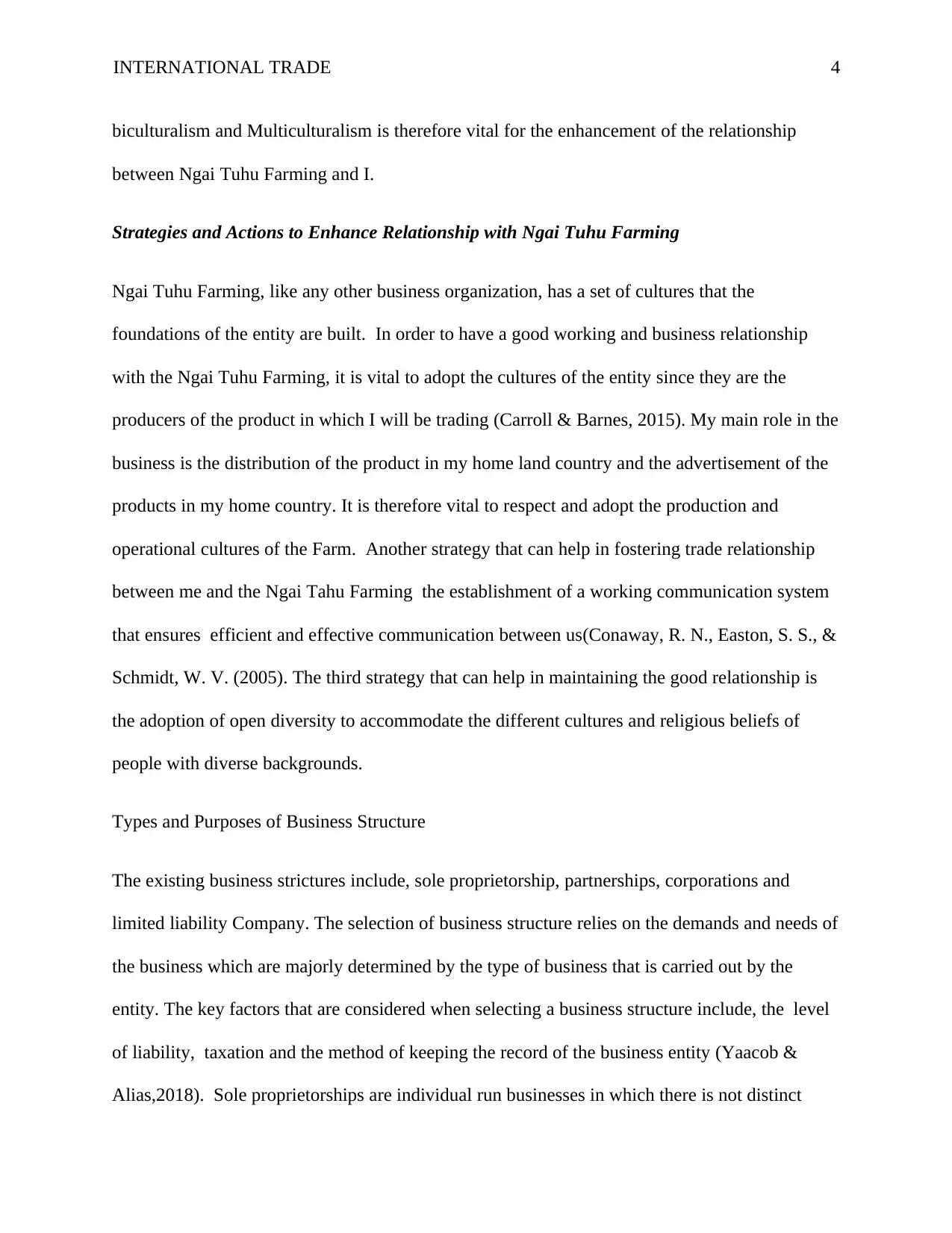
INTERNATIONAL TRADE 4
biculturalism and Multiculturalism is therefore vital for the enhancement of the relationship
between Ngai Tuhu Farming and I.
Strategies and Actions to Enhance Relationship with Ngai Tuhu Farming
Ngai Tuhu Farming, like any other business organization, has a set of cultures that the
foundations of the entity are built. In order to have a good working and business relationship
with the Ngai Tuhu Farming, it is vital to adopt the cultures of the entity since they are the
producers of the product in which I will be trading (Carroll & Barnes, 2015). My main role in the
business is the distribution of the product in my home land country and the advertisement of the
products in my home country. It is therefore vital to respect and adopt the production and
operational cultures of the Farm. Another strategy that can help in fostering trade relationship
between me and the Ngai Tahu Farming the establishment of a working communication system
that ensures efficient and effective communication between us(Conaway, R. N., Easton, S. S., &
Schmidt, W. V. (2005). The third strategy that can help in maintaining the good relationship is
the adoption of open diversity to accommodate the different cultures and religious beliefs of
people with diverse backgrounds.
Types and Purposes of Business Structure
The existing business strictures include, sole proprietorship, partnerships, corporations and
limited liability Company. The selection of business structure relies on the demands and needs of
the business which are majorly determined by the type of business that is carried out by the
entity. The key factors that are considered when selecting a business structure include, the level
of liability, taxation and the method of keeping the record of the business entity (Yaacob &
Alias,2018). Sole proprietorships are individual run businesses in which there is not distinct
biculturalism and Multiculturalism is therefore vital for the enhancement of the relationship
between Ngai Tuhu Farming and I.
Strategies and Actions to Enhance Relationship with Ngai Tuhu Farming
Ngai Tuhu Farming, like any other business organization, has a set of cultures that the
foundations of the entity are built. In order to have a good working and business relationship
with the Ngai Tuhu Farming, it is vital to adopt the cultures of the entity since they are the
producers of the product in which I will be trading (Carroll & Barnes, 2015). My main role in the
business is the distribution of the product in my home land country and the advertisement of the
products in my home country. It is therefore vital to respect and adopt the production and
operational cultures of the Farm. Another strategy that can help in fostering trade relationship
between me and the Ngai Tahu Farming the establishment of a working communication system
that ensures efficient and effective communication between us(Conaway, R. N., Easton, S. S., &
Schmidt, W. V. (2005). The third strategy that can help in maintaining the good relationship is
the adoption of open diversity to accommodate the different cultures and religious beliefs of
people with diverse backgrounds.
Types and Purposes of Business Structure
The existing business strictures include, sole proprietorship, partnerships, corporations and
limited liability Company. The selection of business structure relies on the demands and needs of
the business which are majorly determined by the type of business that is carried out by the
entity. The key factors that are considered when selecting a business structure include, the level
of liability, taxation and the method of keeping the record of the business entity (Yaacob &
Alias,2018). Sole proprietorships are individual run businesses in which there is not distinct
Paraphrase This Document
Need a fresh take? Get an instant paraphrase of this document with our AI Paraphraser
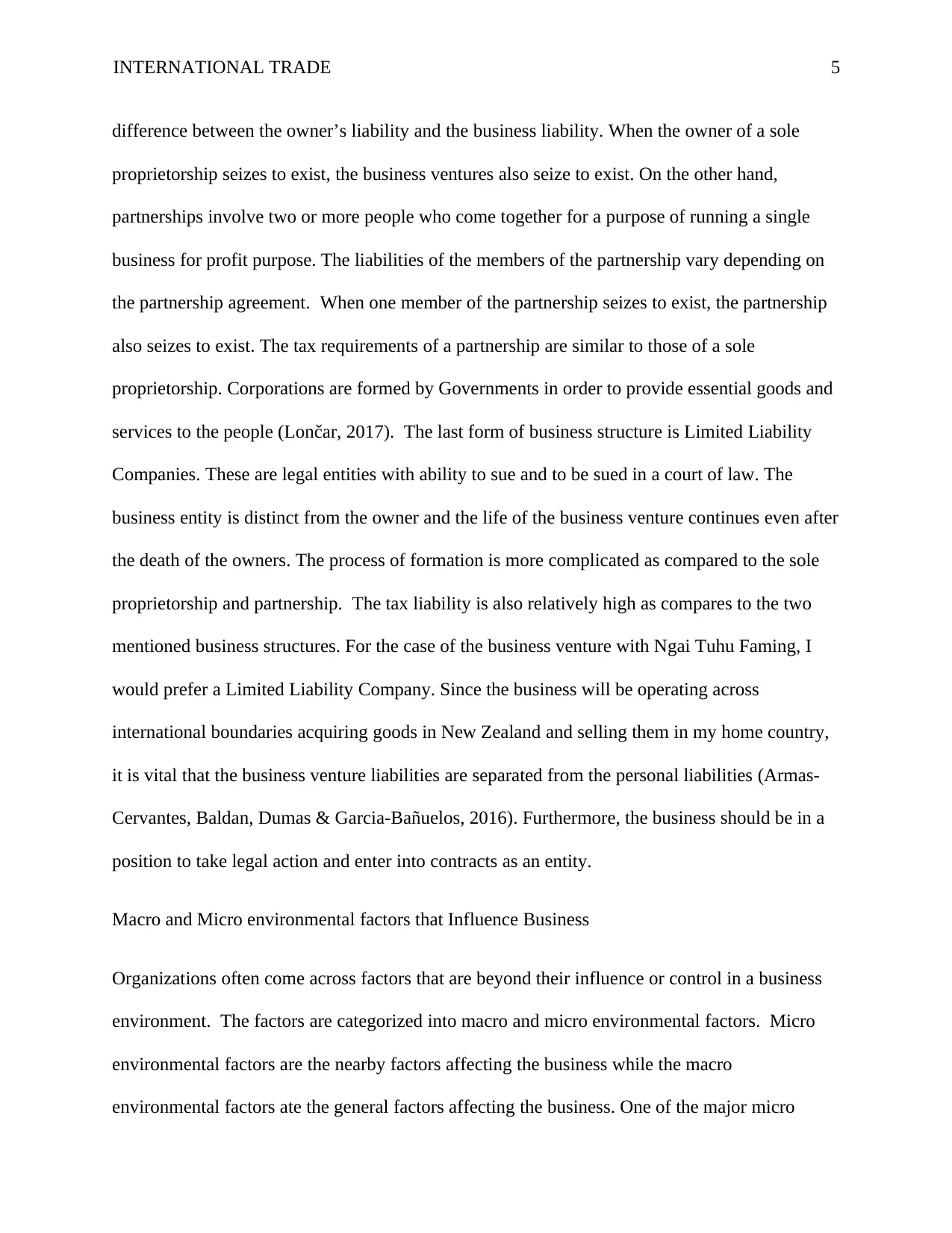
INTERNATIONAL TRADE 5
difference between the owner’s liability and the business liability. When the owner of a sole
proprietorship seizes to exist, the business ventures also seize to exist. On the other hand,
partnerships involve two or more people who come together for a purpose of running a single
business for profit purpose. The liabilities of the members of the partnership vary depending on
the partnership agreement. When one member of the partnership seizes to exist, the partnership
also seizes to exist. The tax requirements of a partnership are similar to those of a sole
proprietorship. Corporations are formed by Governments in order to provide essential goods and
services to the people (Lončar, 2017). The last form of business structure is Limited Liability
Companies. These are legal entities with ability to sue and to be sued in a court of law. The
business entity is distinct from the owner and the life of the business venture continues even after
the death of the owners. The process of formation is more complicated as compared to the sole
proprietorship and partnership. The tax liability is also relatively high as compares to the two
mentioned business structures. For the case of the business venture with Ngai Tuhu Faming, I
would prefer a Limited Liability Company. Since the business will be operating across
international boundaries acquiring goods in New Zealand and selling them in my home country,
it is vital that the business venture liabilities are separated from the personal liabilities (Armas-
Cervantes, Baldan, Dumas & Garcia-Bañuelos, 2016). Furthermore, the business should be in a
position to take legal action and enter into contracts as an entity.
Macro and Micro environmental factors that Influence Business
Organizations often come across factors that are beyond their influence or control in a business
environment. The factors are categorized into macro and micro environmental factors. Micro
environmental factors are the nearby factors affecting the business while the macro
environmental factors ate the general factors affecting the business. One of the major micro
difference between the owner’s liability and the business liability. When the owner of a sole
proprietorship seizes to exist, the business ventures also seize to exist. On the other hand,
partnerships involve two or more people who come together for a purpose of running a single
business for profit purpose. The liabilities of the members of the partnership vary depending on
the partnership agreement. When one member of the partnership seizes to exist, the partnership
also seizes to exist. The tax requirements of a partnership are similar to those of a sole
proprietorship. Corporations are formed by Governments in order to provide essential goods and
services to the people (Lončar, 2017). The last form of business structure is Limited Liability
Companies. These are legal entities with ability to sue and to be sued in a court of law. The
business entity is distinct from the owner and the life of the business venture continues even after
the death of the owners. The process of formation is more complicated as compared to the sole
proprietorship and partnership. The tax liability is also relatively high as compares to the two
mentioned business structures. For the case of the business venture with Ngai Tuhu Faming, I
would prefer a Limited Liability Company. Since the business will be operating across
international boundaries acquiring goods in New Zealand and selling them in my home country,
it is vital that the business venture liabilities are separated from the personal liabilities (Armas-
Cervantes, Baldan, Dumas & Garcia-Bañuelos, 2016). Furthermore, the business should be in a
position to take legal action and enter into contracts as an entity.
Macro and Micro environmental factors that Influence Business
Organizations often come across factors that are beyond their influence or control in a business
environment. The factors are categorized into macro and micro environmental factors. Micro
environmental factors are the nearby factors affecting the business while the macro
environmental factors ate the general factors affecting the business. One of the major micro
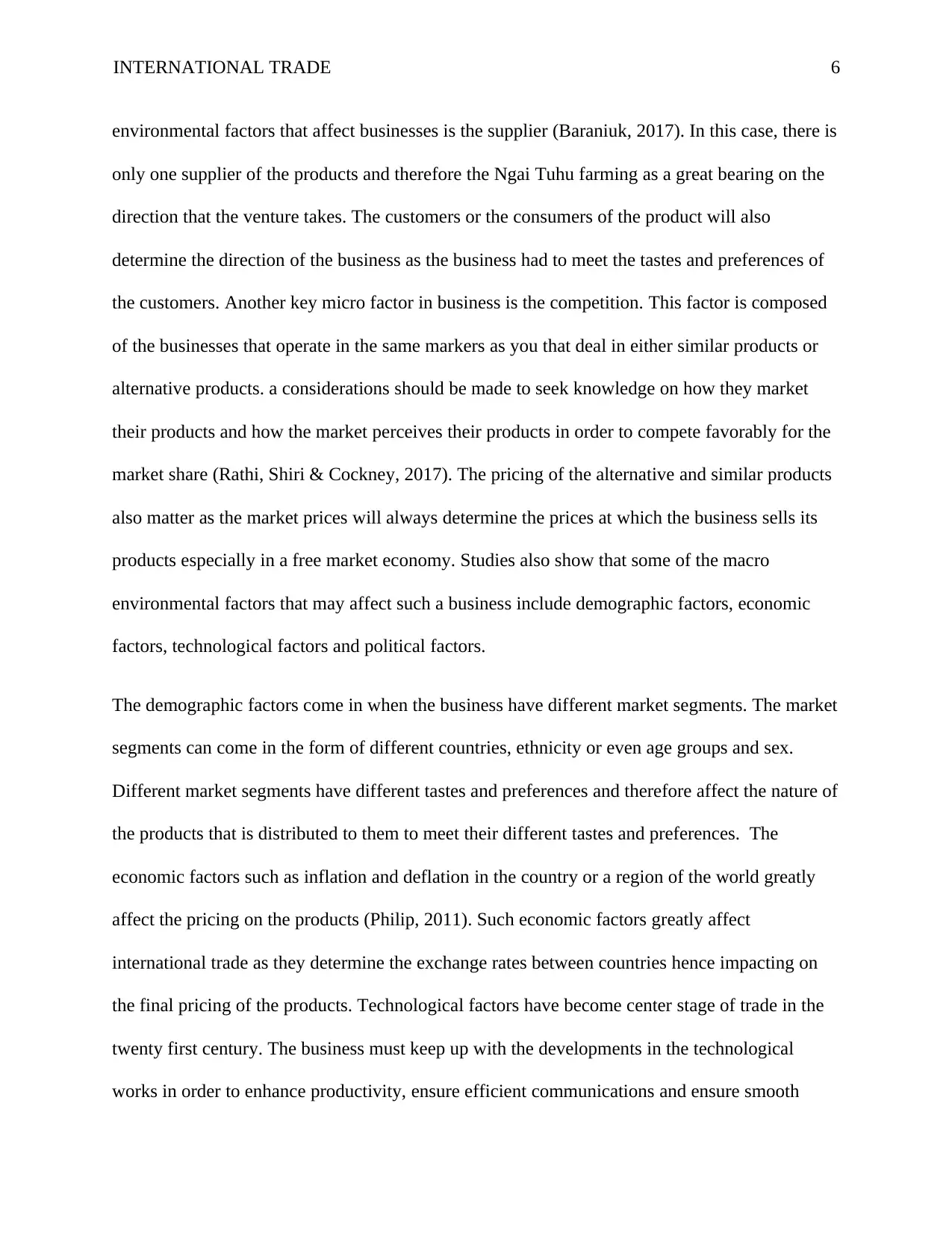
INTERNATIONAL TRADE 6
environmental factors that affect businesses is the supplier (Baraniuk, 2017). In this case, there is
only one supplier of the products and therefore the Ngai Tuhu farming as a great bearing on the
direction that the venture takes. The customers or the consumers of the product will also
determine the direction of the business as the business had to meet the tastes and preferences of
the customers. Another key micro factor in business is the competition. This factor is composed
of the businesses that operate in the same markers as you that deal in either similar products or
alternative products. a considerations should be made to seek knowledge on how they market
their products and how the market perceives their products in order to compete favorably for the
market share (Rathi, Shiri & Cockney, 2017). The pricing of the alternative and similar products
also matter as the market prices will always determine the prices at which the business sells its
products especially in a free market economy. Studies also show that some of the macro
environmental factors that may affect such a business include demographic factors, economic
factors, technological factors and political factors.
The demographic factors come in when the business have different market segments. The market
segments can come in the form of different countries, ethnicity or even age groups and sex.
Different market segments have different tastes and preferences and therefore affect the nature of
the products that is distributed to them to meet their different tastes and preferences. The
economic factors such as inflation and deflation in the country or a region of the world greatly
affect the pricing on the products (Philip, 2011). Such economic factors greatly affect
international trade as they determine the exchange rates between countries hence impacting on
the final pricing of the products. Technological factors have become center stage of trade in the
twenty first century. The business must keep up with the developments in the technological
works in order to enhance productivity, ensure efficient communications and ensure smooth
environmental factors that affect businesses is the supplier (Baraniuk, 2017). In this case, there is
only one supplier of the products and therefore the Ngai Tuhu farming as a great bearing on the
direction that the venture takes. The customers or the consumers of the product will also
determine the direction of the business as the business had to meet the tastes and preferences of
the customers. Another key micro factor in business is the competition. This factor is composed
of the businesses that operate in the same markers as you that deal in either similar products or
alternative products. a considerations should be made to seek knowledge on how they market
their products and how the market perceives their products in order to compete favorably for the
market share (Rathi, Shiri & Cockney, 2017). The pricing of the alternative and similar products
also matter as the market prices will always determine the prices at which the business sells its
products especially in a free market economy. Studies also show that some of the macro
environmental factors that may affect such a business include demographic factors, economic
factors, technological factors and political factors.
The demographic factors come in when the business have different market segments. The market
segments can come in the form of different countries, ethnicity or even age groups and sex.
Different market segments have different tastes and preferences and therefore affect the nature of
the products that is distributed to them to meet their different tastes and preferences. The
economic factors such as inflation and deflation in the country or a region of the world greatly
affect the pricing on the products (Philip, 2011). Such economic factors greatly affect
international trade as they determine the exchange rates between countries hence impacting on
the final pricing of the products. Technological factors have become center stage of trade in the
twenty first century. The business must keep up with the developments in the technological
works in order to enhance productivity, ensure efficient communications and ensure smooth
⊘ This is a preview!⊘
Do you want full access?
Subscribe today to unlock all pages.

Trusted by 1+ million students worldwide
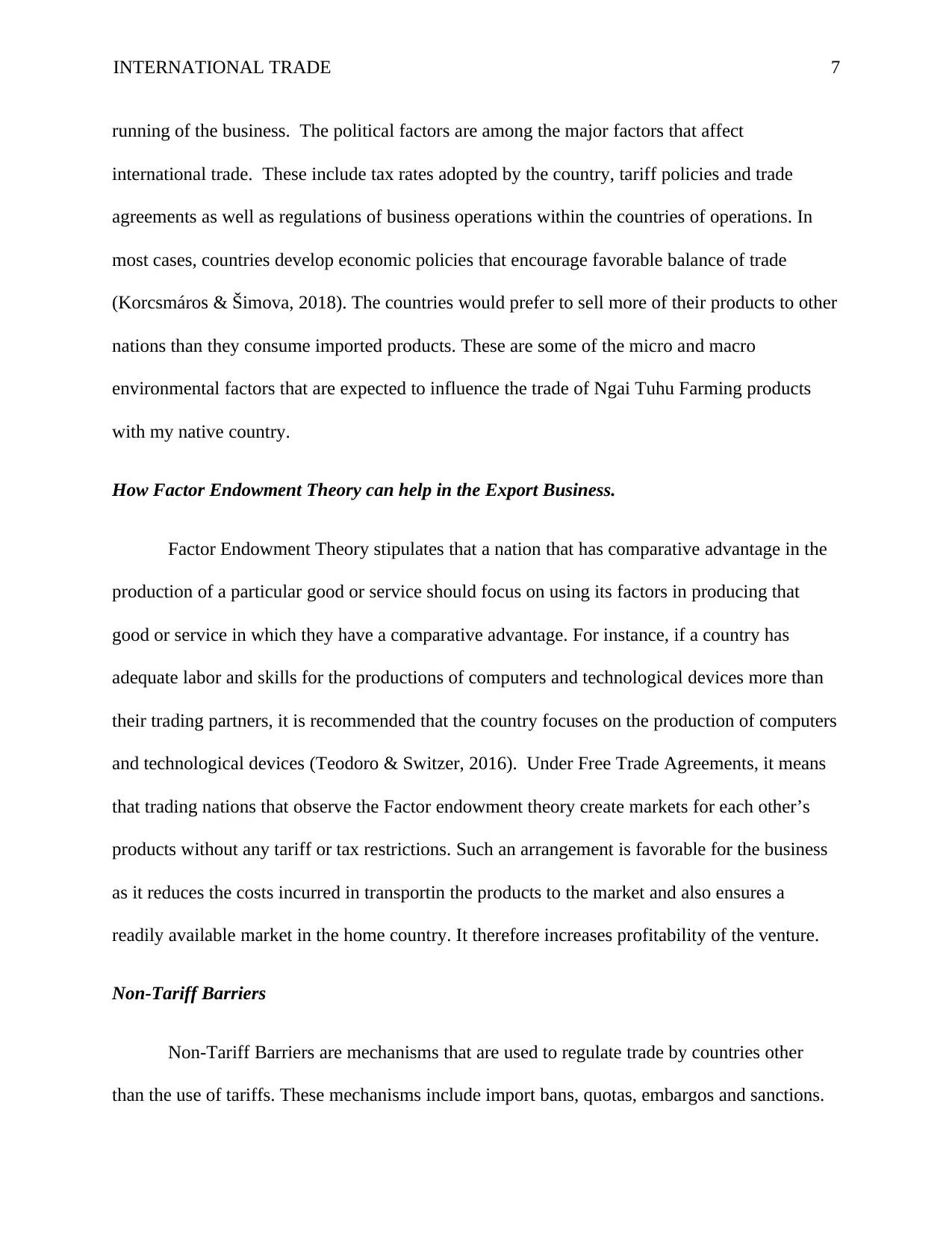
INTERNATIONAL TRADE 7
running of the business. The political factors are among the major factors that affect
international trade. These include tax rates adopted by the country, tariff policies and trade
agreements as well as regulations of business operations within the countries of operations. In
most cases, countries develop economic policies that encourage favorable balance of trade
(Korcsmáros & Šimova, 2018). The countries would prefer to sell more of their products to other
nations than they consume imported products. These are some of the micro and macro
environmental factors that are expected to influence the trade of Ngai Tuhu Farming products
with my native country.
How Factor Endowment Theory can help in the Export Business.
Factor Endowment Theory stipulates that a nation that has comparative advantage in the
production of a particular good or service should focus on using its factors in producing that
good or service in which they have a comparative advantage. For instance, if a country has
adequate labor and skills for the productions of computers and technological devices more than
their trading partners, it is recommended that the country focuses on the production of computers
and technological devices (Teodoro & Switzer, 2016). Under Free Trade Agreements, it means
that trading nations that observe the Factor endowment theory create markets for each other’s
products without any tariff or tax restrictions. Such an arrangement is favorable for the business
as it reduces the costs incurred in transportin the products to the market and also ensures a
readily available market in the home country. It therefore increases profitability of the venture.
Non-Tariff Barriers
Non-Tariff Barriers are mechanisms that are used to regulate trade by countries other
than the use of tariffs. These mechanisms include import bans, quotas, embargos and sanctions.
running of the business. The political factors are among the major factors that affect
international trade. These include tax rates adopted by the country, tariff policies and trade
agreements as well as regulations of business operations within the countries of operations. In
most cases, countries develop economic policies that encourage favorable balance of trade
(Korcsmáros & Šimova, 2018). The countries would prefer to sell more of their products to other
nations than they consume imported products. These are some of the micro and macro
environmental factors that are expected to influence the trade of Ngai Tuhu Farming products
with my native country.
How Factor Endowment Theory can help in the Export Business.
Factor Endowment Theory stipulates that a nation that has comparative advantage in the
production of a particular good or service should focus on using its factors in producing that
good or service in which they have a comparative advantage. For instance, if a country has
adequate labor and skills for the productions of computers and technological devices more than
their trading partners, it is recommended that the country focuses on the production of computers
and technological devices (Teodoro & Switzer, 2016). Under Free Trade Agreements, it means
that trading nations that observe the Factor endowment theory create markets for each other’s
products without any tariff or tax restrictions. Such an arrangement is favorable for the business
as it reduces the costs incurred in transportin the products to the market and also ensures a
readily available market in the home country. It therefore increases profitability of the venture.
Non-Tariff Barriers
Non-Tariff Barriers are mechanisms that are used to regulate trade by countries other
than the use of tariffs. These mechanisms include import bans, quotas, embargos and sanctions.
Paraphrase This Document
Need a fresh take? Get an instant paraphrase of this document with our AI Paraphraser
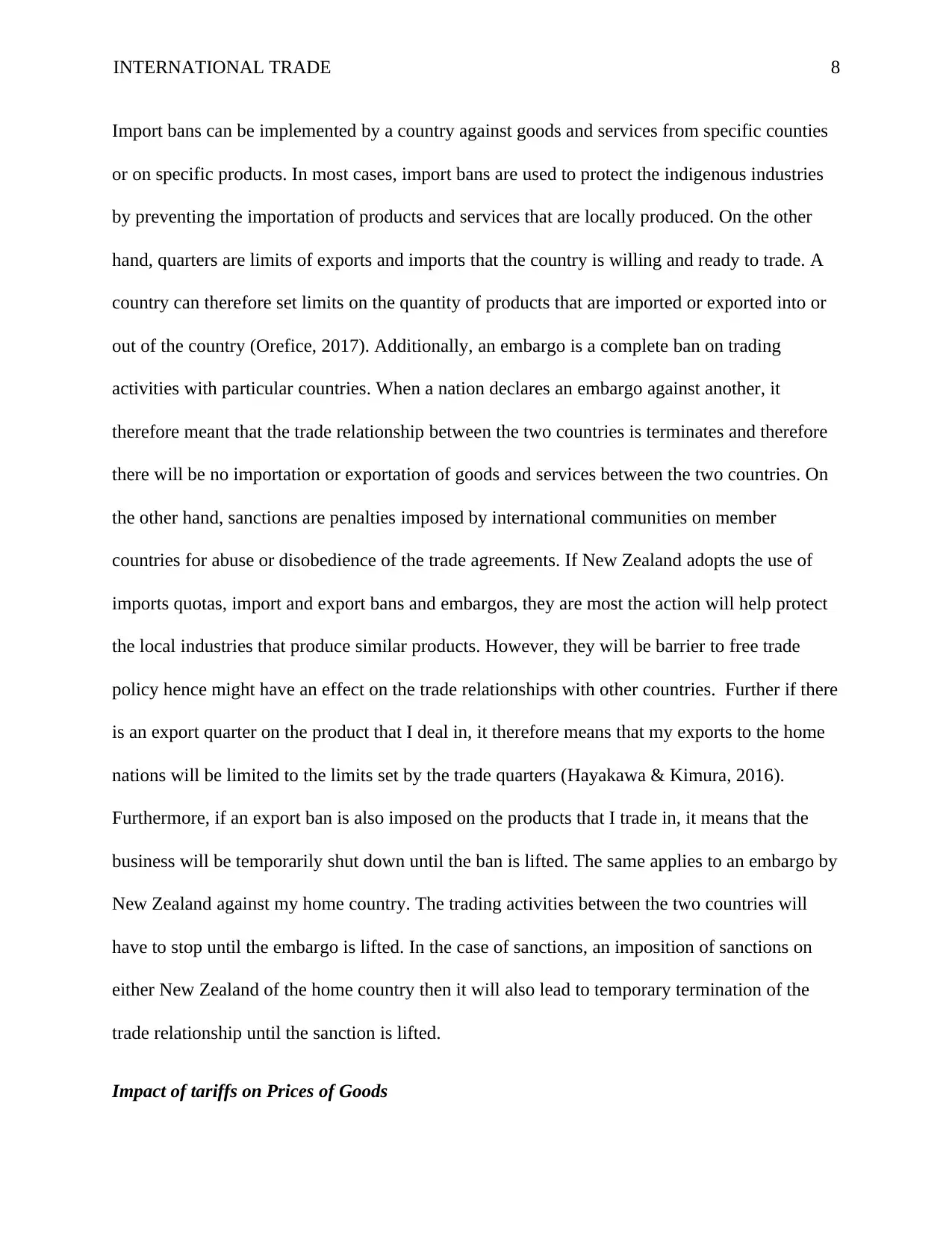
INTERNATIONAL TRADE 8
Import bans can be implemented by a country against goods and services from specific counties
or on specific products. In most cases, import bans are used to protect the indigenous industries
by preventing the importation of products and services that are locally produced. On the other
hand, quarters are limits of exports and imports that the country is willing and ready to trade. A
country can therefore set limits on the quantity of products that are imported or exported into or
out of the country (Orefice, 2017). Additionally, an embargo is a complete ban on trading
activities with particular countries. When a nation declares an embargo against another, it
therefore meant that the trade relationship between the two countries is terminates and therefore
there will be no importation or exportation of goods and services between the two countries. On
the other hand, sanctions are penalties imposed by international communities on member
countries for abuse or disobedience of the trade agreements. If New Zealand adopts the use of
imports quotas, import and export bans and embargos, they are most the action will help protect
the local industries that produce similar products. However, they will be barrier to free trade
policy hence might have an effect on the trade relationships with other countries. Further if there
is an export quarter on the product that I deal in, it therefore means that my exports to the home
nations will be limited to the limits set by the trade quarters (Hayakawa & Kimura, 2016).
Furthermore, if an export ban is also imposed on the products that I trade in, it means that the
business will be temporarily shut down until the ban is lifted. The same applies to an embargo by
New Zealand against my home country. The trading activities between the two countries will
have to stop until the embargo is lifted. In the case of sanctions, an imposition of sanctions on
either New Zealand of the home country then it will also lead to temporary termination of the
trade relationship until the sanction is lifted.
Impact of tariffs on Prices of Goods
Import bans can be implemented by a country against goods and services from specific counties
or on specific products. In most cases, import bans are used to protect the indigenous industries
by preventing the importation of products and services that are locally produced. On the other
hand, quarters are limits of exports and imports that the country is willing and ready to trade. A
country can therefore set limits on the quantity of products that are imported or exported into or
out of the country (Orefice, 2017). Additionally, an embargo is a complete ban on trading
activities with particular countries. When a nation declares an embargo against another, it
therefore meant that the trade relationship between the two countries is terminates and therefore
there will be no importation or exportation of goods and services between the two countries. On
the other hand, sanctions are penalties imposed by international communities on member
countries for abuse or disobedience of the trade agreements. If New Zealand adopts the use of
imports quotas, import and export bans and embargos, they are most the action will help protect
the local industries that produce similar products. However, they will be barrier to free trade
policy hence might have an effect on the trade relationships with other countries. Further if there
is an export quarter on the product that I deal in, it therefore means that my exports to the home
nations will be limited to the limits set by the trade quarters (Hayakawa & Kimura, 2016).
Furthermore, if an export ban is also imposed on the products that I trade in, it means that the
business will be temporarily shut down until the ban is lifted. The same applies to an embargo by
New Zealand against my home country. The trading activities between the two countries will
have to stop until the embargo is lifted. In the case of sanctions, an imposition of sanctions on
either New Zealand of the home country then it will also lead to temporary termination of the
trade relationship until the sanction is lifted.
Impact of tariffs on Prices of Goods
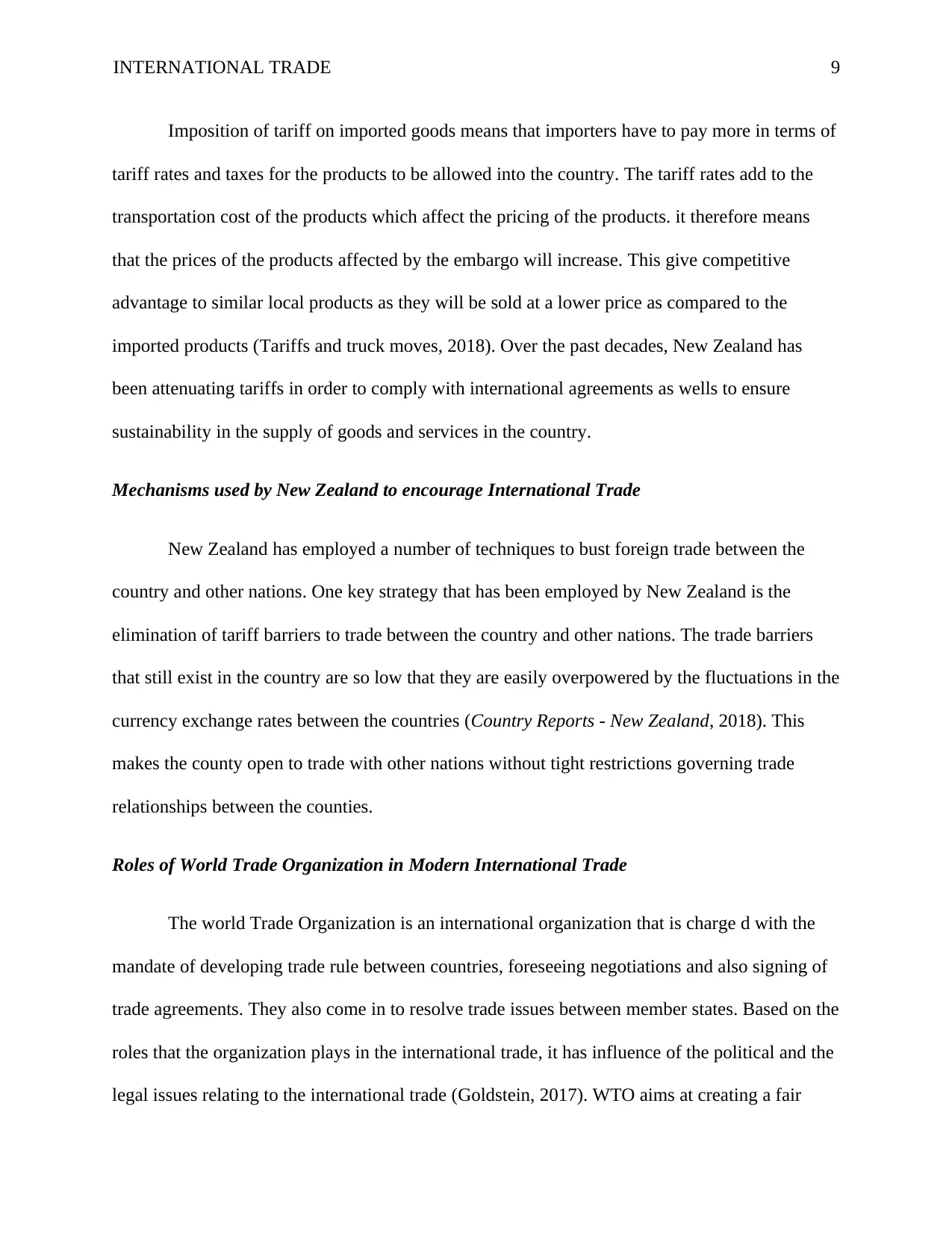
INTERNATIONAL TRADE 9
Imposition of tariff on imported goods means that importers have to pay more in terms of
tariff rates and taxes for the products to be allowed into the country. The tariff rates add to the
transportation cost of the products which affect the pricing of the products. it therefore means
that the prices of the products affected by the embargo will increase. This give competitive
advantage to similar local products as they will be sold at a lower price as compared to the
imported products (Tariffs and truck moves, 2018). Over the past decades, New Zealand has
been attenuating tariffs in order to comply with international agreements as wells to ensure
sustainability in the supply of goods and services in the country.
Mechanisms used by New Zealand to encourage International Trade
New Zealand has employed a number of techniques to bust foreign trade between the
country and other nations. One key strategy that has been employed by New Zealand is the
elimination of tariff barriers to trade between the country and other nations. The trade barriers
that still exist in the country are so low that they are easily overpowered by the fluctuations in the
currency exchange rates between the countries (Country Reports - New Zealand, 2018). This
makes the county open to trade with other nations without tight restrictions governing trade
relationships between the counties.
Roles of World Trade Organization in Modern International Trade
The world Trade Organization is an international organization that is charge d with the
mandate of developing trade rule between countries, foreseeing negotiations and also signing of
trade agreements. They also come in to resolve trade issues between member states. Based on the
roles that the organization plays in the international trade, it has influence of the political and the
legal issues relating to the international trade (Goldstein, 2017). WTO aims at creating a fair
Imposition of tariff on imported goods means that importers have to pay more in terms of
tariff rates and taxes for the products to be allowed into the country. The tariff rates add to the
transportation cost of the products which affect the pricing of the products. it therefore means
that the prices of the products affected by the embargo will increase. This give competitive
advantage to similar local products as they will be sold at a lower price as compared to the
imported products (Tariffs and truck moves, 2018). Over the past decades, New Zealand has
been attenuating tariffs in order to comply with international agreements as wells to ensure
sustainability in the supply of goods and services in the country.
Mechanisms used by New Zealand to encourage International Trade
New Zealand has employed a number of techniques to bust foreign trade between the
country and other nations. One key strategy that has been employed by New Zealand is the
elimination of tariff barriers to trade between the country and other nations. The trade barriers
that still exist in the country are so low that they are easily overpowered by the fluctuations in the
currency exchange rates between the countries (Country Reports - New Zealand, 2018). This
makes the county open to trade with other nations without tight restrictions governing trade
relationships between the counties.
Roles of World Trade Organization in Modern International Trade
The world Trade Organization is an international organization that is charge d with the
mandate of developing trade rule between countries, foreseeing negotiations and also signing of
trade agreements. They also come in to resolve trade issues between member states. Based on the
roles that the organization plays in the international trade, it has influence of the political and the
legal issues relating to the international trade (Goldstein, 2017). WTO aims at creating a fair
⊘ This is a preview!⊘
Do you want full access?
Subscribe today to unlock all pages.

Trusted by 1+ million students worldwide
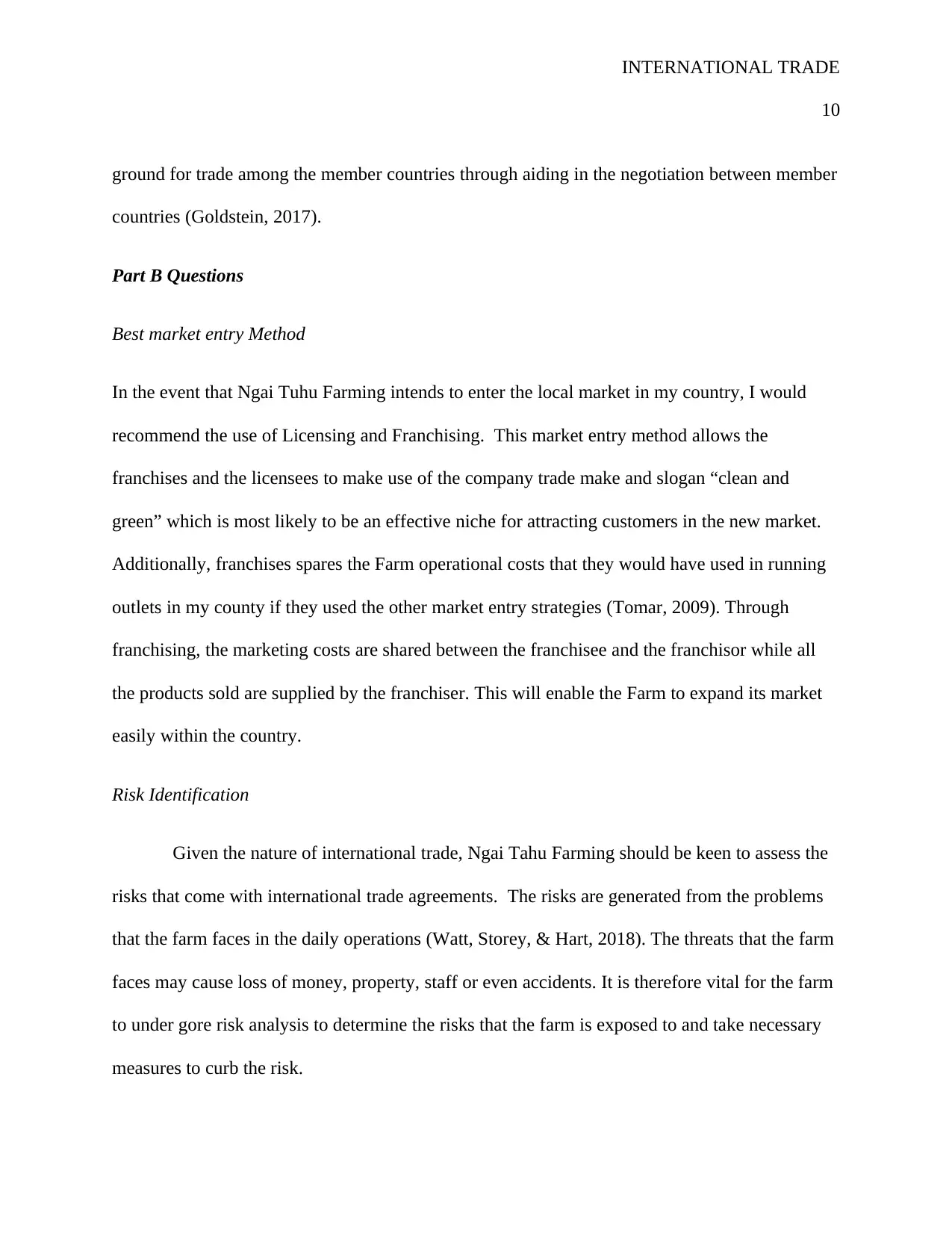
INTERNATIONAL TRADE
10
ground for trade among the member countries through aiding in the negotiation between member
countries (Goldstein, 2017).
Part B Questions
Best market entry Method
In the event that Ngai Tuhu Farming intends to enter the local market in my country, I would
recommend the use of Licensing and Franchising. This market entry method allows the
franchises and the licensees to make use of the company trade make and slogan “clean and
green” which is most likely to be an effective niche for attracting customers in the new market.
Additionally, franchises spares the Farm operational costs that they would have used in running
outlets in my county if they used the other market entry strategies (Tomar, 2009). Through
franchising, the marketing costs are shared between the franchisee and the franchisor while all
the products sold are supplied by the franchiser. This will enable the Farm to expand its market
easily within the country.
Risk Identification
Given the nature of international trade, Ngai Tahu Farming should be keen to assess the
risks that come with international trade agreements. The risks are generated from the problems
that the farm faces in the daily operations (Watt, Storey, & Hart, 2018). The threats that the farm
faces may cause loss of money, property, staff or even accidents. It is therefore vital for the farm
to under gore risk analysis to determine the risks that the farm is exposed to and take necessary
measures to curb the risk.
10
ground for trade among the member countries through aiding in the negotiation between member
countries (Goldstein, 2017).
Part B Questions
Best market entry Method
In the event that Ngai Tuhu Farming intends to enter the local market in my country, I would
recommend the use of Licensing and Franchising. This market entry method allows the
franchises and the licensees to make use of the company trade make and slogan “clean and
green” which is most likely to be an effective niche for attracting customers in the new market.
Additionally, franchises spares the Farm operational costs that they would have used in running
outlets in my county if they used the other market entry strategies (Tomar, 2009). Through
franchising, the marketing costs are shared between the franchisee and the franchisor while all
the products sold are supplied by the franchiser. This will enable the Farm to expand its market
easily within the country.
Risk Identification
Given the nature of international trade, Ngai Tahu Farming should be keen to assess the
risks that come with international trade agreements. The risks are generated from the problems
that the farm faces in the daily operations (Watt, Storey, & Hart, 2018). The threats that the farm
faces may cause loss of money, property, staff or even accidents. It is therefore vital for the farm
to under gore risk analysis to determine the risks that the farm is exposed to and take necessary
measures to curb the risk.
Paraphrase This Document
Need a fresh take? Get an instant paraphrase of this document with our AI Paraphraser
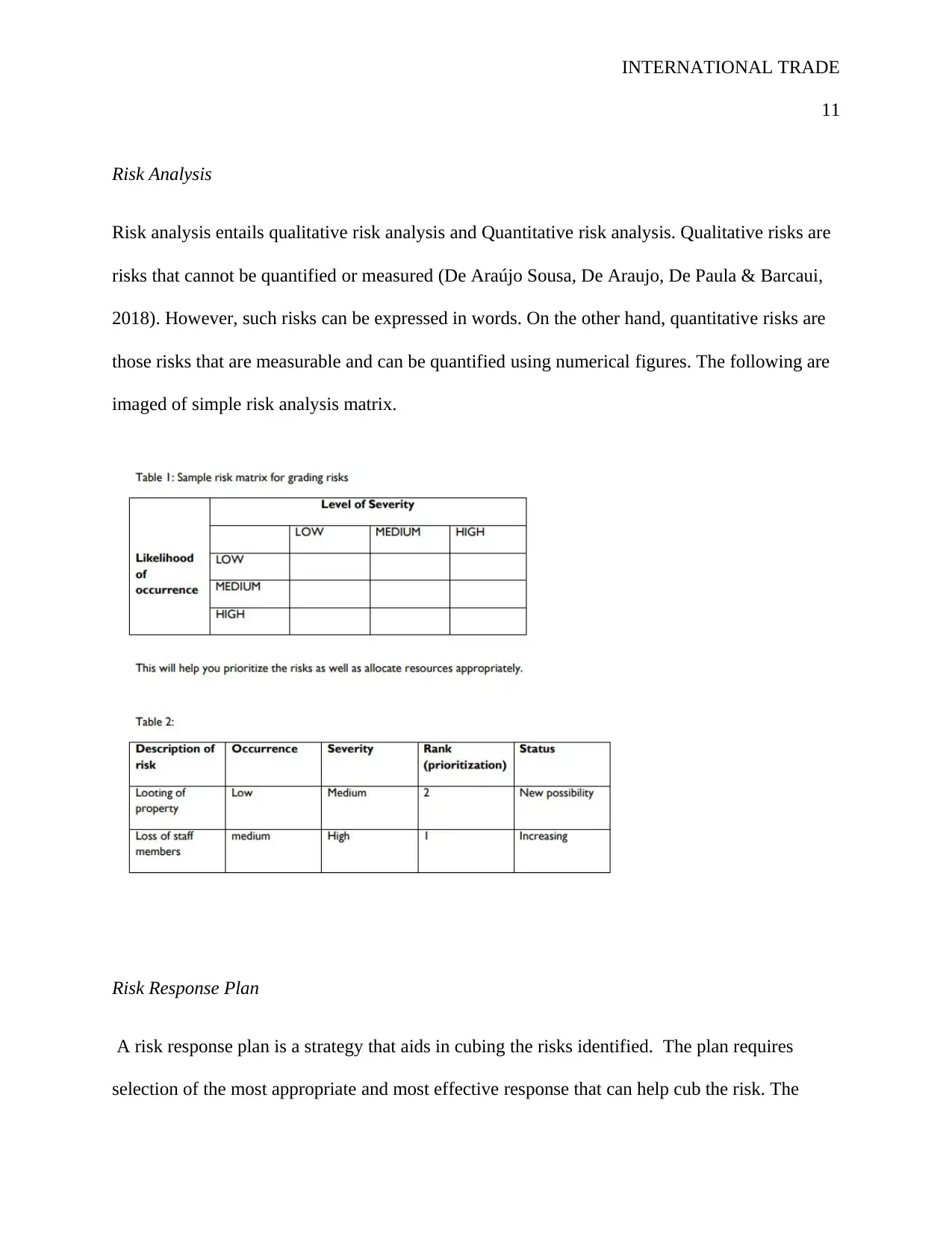
INTERNATIONAL TRADE
11
Risk Analysis
Risk analysis entails qualitative risk analysis and Quantitative risk analysis. Qualitative risks are
risks that cannot be quantified or measured (De Araújo Sousa, De Araujo, De Paula & Barcaui,
2018). However, such risks can be expressed in words. On the other hand, quantitative risks are
those risks that are measurable and can be quantified using numerical figures. The following are
imaged of simple risk analysis matrix.
Risk Response Plan
A risk response plan is a strategy that aids in cubing the risks identified. The plan requires
selection of the most appropriate and most effective response that can help cub the risk. The
11
Risk Analysis
Risk analysis entails qualitative risk analysis and Quantitative risk analysis. Qualitative risks are
risks that cannot be quantified or measured (De Araújo Sousa, De Araujo, De Paula & Barcaui,
2018). However, such risks can be expressed in words. On the other hand, quantitative risks are
those risks that are measurable and can be quantified using numerical figures. The following are
imaged of simple risk analysis matrix.
Risk Response Plan
A risk response plan is a strategy that aids in cubing the risks identified. The plan requires
selection of the most appropriate and most effective response that can help cub the risk. The
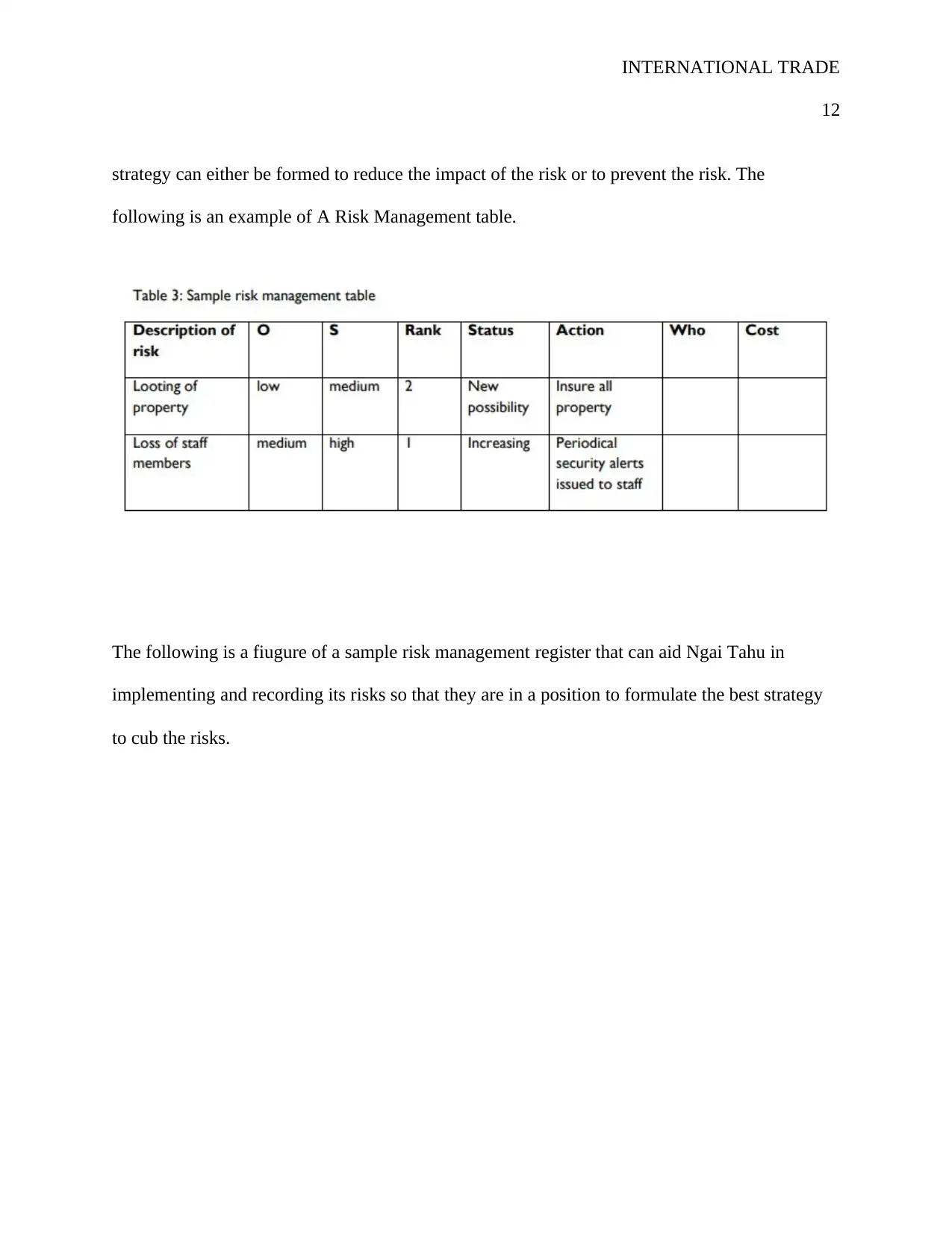
INTERNATIONAL TRADE
12
strategy can either be formed to reduce the impact of the risk or to prevent the risk. The
following is an example of A Risk Management table.
The following is a fiugure of a sample risk management register that can aid Ngai Tahu in
implementing and recording its risks so that they are in a position to formulate the best strategy
to cub the risks.
12
strategy can either be formed to reduce the impact of the risk or to prevent the risk. The
following is an example of A Risk Management table.
The following is a fiugure of a sample risk management register that can aid Ngai Tahu in
implementing and recording its risks so that they are in a position to formulate the best strategy
to cub the risks.
⊘ This is a preview!⊘
Do you want full access?
Subscribe today to unlock all pages.

Trusted by 1+ million students worldwide
1 out of 18
Related Documents
Your All-in-One AI-Powered Toolkit for Academic Success.
+13062052269
info@desklib.com
Available 24*7 on WhatsApp / Email
![[object Object]](/_next/static/media/star-bottom.7253800d.svg)
Unlock your academic potential
Copyright © 2020–2025 A2Z Services. All Rights Reserved. Developed and managed by ZUCOL.





